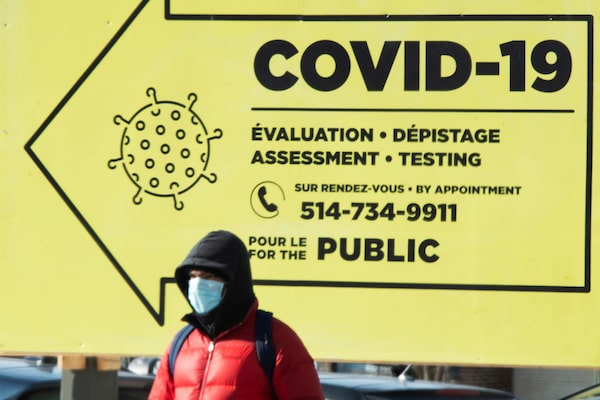
A man walks past a COVID-19 testing clinic, in Montreal, on Feb. 12, 2021.Ryan Remiorz/The Canadian Press
Health officials in Quebec City pleaded with residents on Friday to follow health orders after the capital region reported the highest number of new daily COVID-19 infections in the province for a second consecutive day.
Quebec City had 449 new cases compared to 392 in Montreal, a city more than three times its size. The region south of the provincial capital, Chaudiere-Appalaches, reported 218 new cases.
“We don’t know how it’ll evolve in the coming days,” Dr. Andre Dontigny, head of public health for the provincial capital health region, told reporters. “Will it reach a plateau? Will it continue to increase?”
He said 70 per cent of the new cases reported in Quebec City involve the B.1.1.7 mutation of the novel coronavirus, which is considered more contagious and virulent than the original strain.
Canada vaccine tracker: How many COVID-19 doses have been administered so far?
Dontigny said variants will continue to play a larger role. “That’s the new pandemic, in a way,” he said.
The provincial government has placed Quebec City, Levis, Gatineau and several municipalities in the Beauce region under emergency measures, closing schools and non-essential businesses in those areas and applying an 8 p.m. curfew.
The health order was extended on Thursday until at least April 18, and it is unclear whether it will need to be extended further in the provincial capital, Dontigny said.
As of Friday, authorities had linked at least 506 cases in the region to the Mega Fitness Gym – 208 cases linked directly to the Quebec City facility and another 298 secondary infections from 40 related outbreaks.
Dontigny said the gym is an example of the kind of outbreak officials don’t want to see, but it alone doesn’t explain Quebec City’s high case count. He said the region had noted a rise in cases of the B.1.1.7 variant in late March, before it struck gym clients. Also, he said, the lifting of some restrictions in the area may have contributed to the spread.
On Thursday, Quebec Premier Francois Legault also announced a return to an 8 p.m. curfew for Montreal and Laval beginning Sunday, calling it a preventive measure. Montreal Mayor Valerie Plante acknowledged that people in the city are at their wits’ end.
“For me, this measure is a lesser evil. I prefer a curfew instead of a lockdown if the situation degenerates further,” she said in a video posted to Facebook. “We were the epicentre of the first wave, and I don’t want to happen again with this third wave.”
Quebec reported 1,683 new COVID-19 cases Friday and eight more deaths attributed to the novel coronavirus, including five in the previous 24 hours. Health officials said hospitalizations rose by three, to 569, and 134 people were in intensive care, a rise of two.
Quebec set a single day record for COVID-19 vaccinations Thursday with 69,148 doses administered, including 16,161 Oxford-AstraZeneca shots that were administered at special walk-in clinics for those 55 and older wanting that specific vaccine.
The AstraZeneca vaccine is currently only available to those between the ages of 55 and 79, after the government suspended its use in younger people over concerns about rare but serious blood clots.
The province has now vaccinated 1,754,749 people with a dose of vaccine, representing about 20.6 per cent of the population.
Late Thursday, Quebec announced the first 13 companies that will operate clinics in their workplaces, with each site able to vaccinate up to 25,000 people between May and August.
Participating companies include National Bank, Bell, and Groupe CH, owner of the Montreal Canadiens NHL team. The clinics will be located in eight different health regions and should be operational by May 1.
Montreal’s airport authority will partner with Air Canada and Bombardier to create a vaccination hub that will operate two sites at the departure level of the airport terminal and in a nearby Bombardier hangar.
The Quebec government said 450 companies offered to help the inoculation campaign.
Sign up for the Coronavirus Update newsletter to read the day’s essential coronavirus news, features and explainers written by Globe reporters and editors.